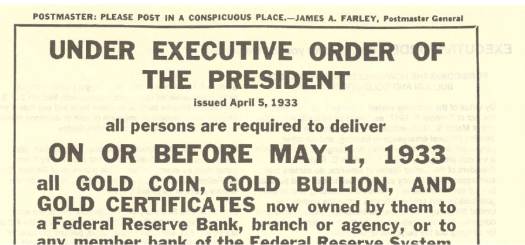History And Lies About the Gold Confiscation Act
The Executive Order 6102 and gold confiscation act effectively seized all gold coin and bullion from citizens of the US in 1933, the history of order 6102 can be found below. Confiscation of personal value possessions sounds so outrageous today that ‘gold confiscation 2012’ is almost trending on twitter (well, not really, but people are talking about it). Here are three things people say about the topic which may well not hold in reality:
Should You Be Worried?
The grandiose wording and air of conspiracy about the idea of government seizing of assets is itself an indication that someone may be trying to make fools out of us. Cleverly engineered rumors such as this can quickly spread from mouth to mouth, and increasingly so across media, trying desperately for some attention. While knowing our economic history, including the events around the 1933 gold confiscation, is surely helpful, this may not be the most important thing to occupy our minds right now.
For example, if the US economy is headed for steady recovery and gold follows suit as a less attractive investment in the medium run, it’s viable that some investor planned to dump his huge supply of, say, collectible gold coins. Nothing is better for selling than a sky-rocketed gold price through spreading fears of the possibility of a new gold confiscation in or beyond 2012; besides collectibles were protected in 1933, right? All of this done at almost no cost today.
Click The Image Below To View A Copy Of The Confiscation Act

Gold Confiscation: Can It Happen Again?
The US government may declare that no citizen of the United States is a citizen, if that citizen hoards gold! Or impose strict fines. Government officials could do what was not done in 1933 – inspect houses. Surely your gold is safer in Canada, or in Cuba.
Or perhaps there is a new world order to be, known to a pre-selected few. Latest research shows that the relatively free market world economy, based on sovereign free-floating exchange rates, is no longer the best option for the United States. Further, it is known, but we do not know who knows it, that the US adopting a 2012 gold standard is a better preferred option – whoever wants to have more money, ceteris paribus?
Gold Confiscation: May Not Happen Again
Well, we never know. If you want to play on the safe side, diversification is the way to go. Combine low risk and high premium assets, and you may well not lose much in such a contingency. If any similar order were promulgated today (i.e.,a gold confiscation order), say in a country with a huge balance of payments deficit, and given that all national currencies are no longer pegged to the value of any uniform commodity, such an order would probably end up being as unenforceable as EO 6102. Depending on their level of trust on their government, people would either voluntarily and willingly surrender their gold for the sake of their country (or ruling elites) or sell their gold for “harder” currencies that will enable them to pay for imports in case the local prices of basic commodities shoot up out of control.
The History Of The Executive Order 6102
Franklin D. Roosevelt’s Executive Order 6102, or what can be nicknamed as the “gold confiscation act,” made it unlawful for any US individual or organization to retain or store gold coin, gold bullion, and gold certificates except for industrial, artistic, numismatic, and a few other allowable exceptions. As it was written, EO 6102 was invalid and can easily be circumvented. The order empowered the Secretary of the Treasury to acquire gold from US individuals and organizations.
It was therefore the Secretary of the Treasury who alone had the power to compel individuals and organizations to surrender their gold. But since the Secretary was not a signatory to EO 6102 (only the President), then the Secretary technically did not have the power to enforce this Order and to hold non-compliant individuals and organizations in breach of the law. Also, individuals and organizations could have simply registered themselves as jewelry artisans, for example, and thereby obtained sufficient time to hide or ship their gold out of the country.
EO 6102 was enabled by the Emergency Banking Relief Act, which was passed by the US Congress on March 09, 1933. Title I, Section 3 of the Act states that the Secretary of the Treasury had the power to dis posses persons or groups in the US of their gold artifacts as required to provide the President with adequate control over the financial status of the nation.
EO 6102 was really intended to “encourage” Americans to spend their money on other things except gold. It was superseded by more forward-looking executive orders and by the Gold Reserve Act of 1934. But the main idea behind the gold confiscation order of 1933, as well as the subsequent laws that were passed after it, was to revitalize American industry, which is what did happen later on.









